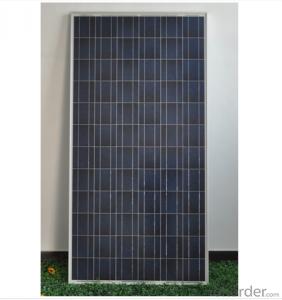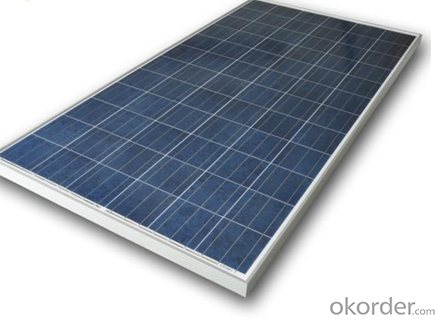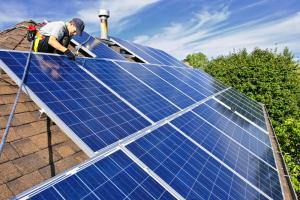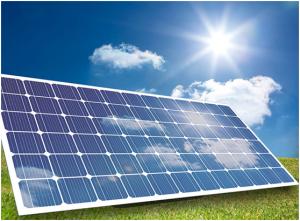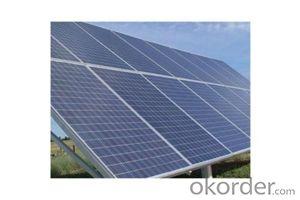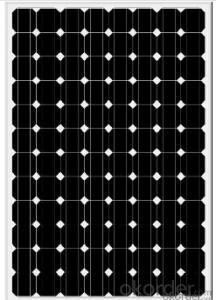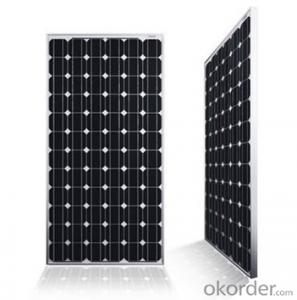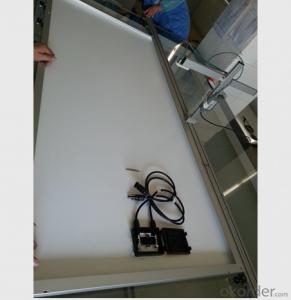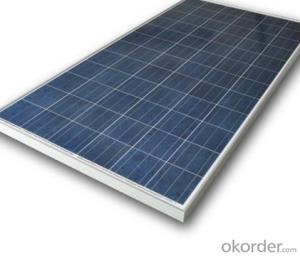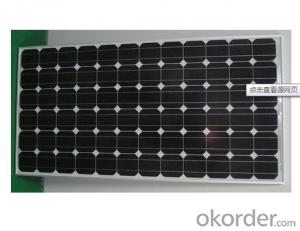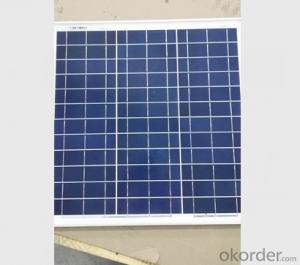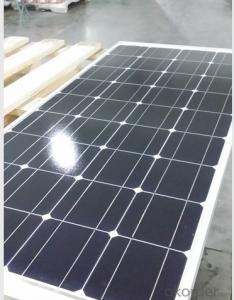SMUD Solar Panels Polycrystalline CNPV-310W High Performance 72 Cell
- Loading Port:
- Shanghai
- Payment Terms:
- TT OR LC
- Min Order Qty:
- 25 pc
- Supply Capability:
- 100000 pc/month
OKorder Service Pledge
OKorder Financial Service
You Might Also Like
Product Description:
Solar Polycrystalline Series Panels
Introduction of Solar Polycrystalline Series Panels
CNBM Solar photovoltaic (PV) Panel is designed for large electrical power requirements. It is the optimal choice for both on-grid and off-grid power systems. CNBM Solar panel offers high performance of power per square foot of solar array. Monocrystalline silicon(c-Si): often made using the Czochralski process. Single-crystal wafer cells tend to be expensive, and because they are cut from cylindrical ingots, do not completely cover a square solar cell module without a substantial waste of refined silicon. Hence most c-Si panels have uncovered gaps at the four corners of the cells.
Standard Test Conditions of Solar Polycrystalline Series Panels
The opto-electrical specifications shown below are stabilized values being measured at Standard Test Conditions, Irradiance: 1000W/m2, Spectrum: AM1.5 at 25°C, The info below is subject to manufacturing tolerances. Where appropriate minutes of measurement are available and are used for the dimensioning of the installation.
Advantages of Solar Polycrystalline Series Panels
• Solar performance guarantees for 25 years
• 12 years guarantee for workmanship
• Timeliness of delivery
Characteristics of Solar Polycrystalline Series Panels
Max Power Voltage Vmp (V) | 37V |
Max Power Current Imp (A) | 8.4A |
Open Circuit Voltage Voc (V) | 45.8V |
Short Circuit Current Isc (A) | 8.95A |
Max Power Pm (W) | 310W |
Temperature Coefficient of Cells
NOCT | 47℃±2℃ |
Temperature Coefficients of Isc (%/℃) | 0.064 |
Temperature Coefficients of Voc (%/℃) | -0.33 |
Temperature Coefficients of Pmp (%/℃) | -0.45 |
Mechanical Data Solar Polyocrystalline Series
Power | 310W |
Dimension | 1965×992×35mm |
Weight | 22kg |
Tolerance | ±3% |
The dimension of the modules can be changed according to the demand of clients
Limits
Operating Temperature | –40 °C to +85°C |
Storage Temperature | –40 °C to +85°C |
Max System Voltage | 700V |
Guarantee Solar Polyocrystalline Series Panels
Products Guarantee | 12 yrs free from defects in materials and workmanship |
Performance Guarantee | No less than 90% within 10yrs and no less than 80% within 25yrs |
Certificates | UL, IEC, ISO, TUV, CE |
The Examination of Solar Polyocrystalline Series Panels
FAQ
We have organized several common questions for our clients,may help you sincerely:
①What price for each watt?
It depends on the quantity, delivery date and payment terms,
②What is your size for each module? Can you tell me the Parameter of your module?
We have different series of panels in different output, both c-Si and a-Si. Please take the specification sheet for your reference.
③Can you provide the peripheral products of the solar panels, such as the battery, controller, and inverter? If so, can you tell me how do they match each other?
Yes, we can, we have two companies for solar region, one is CNBM International, the other is CNBM engineering Co.
We can provide you not only the solar module but also the off grid solar system, we can also provide you service with on grid plant.
④What is your warranty system?
Our product performance guarantees for 25 years
• 12 years guarantee for workmanship
• Timeliness of delivery
• Quality Products certified (TÜV, UL, CE, ISO)
⑤How do you pack your products?
We have rich experience on how to pack the panels to make sure the safety on shipment when it arrives at the destination.
⑥ Can you do OEM for us?
Yes, we can.
⑦How long can we receive the product after purchase?
In the purchase of product within three working days, We will arrange the factory delivery as soon as possible. The pecific time of receiving is related to the state and position of customers.Commonly 7 to 10 working days can be served.
- Q: can anyone help me? i was thinking of installing solar panels to cut bills but would it be a waste considering its gonna need a circulating pump running almost 24/7 (which will use electricity) and even still will only provide me with quot;warmwater? also would it be possible to install the solar panels for the sole purpose of providing sufficient power to run electric heaters instead of using gas/oil? this way allowing me to have a warm house without the expensive bills. brobably talking about running 7 heaters/electric radiators.
- Are you thinking of installing electric solar panels or thermal solar panels or both? It would be better to install electric solar panels for electric heating. You can run 7 heaters as long as you do the calculations for the number of panels need for the daylight hours, and the required battery bank to supply the required power.
- Q: where I can find solar panel the has 4.8 volts? Like those solar walkway light or something that has 4.8 volts solar panel.Do you think I can get it from home depot?
- How Solar Cells Work by Scott Aldous Inside This Article . Introduction to How Solar Cells Work 2. Photovoltaic Cells: Converting Photons to Electrons 3. How Silicon Makes a Solar Cell 4. Anatomy of a Solar Cell 5. Energy Loss in a Solar Cell 6. Solar-powering a House 7. Solving Solar-power Issues 8. Solar-power Pros and Cons 9. Lots More Information 0. See all Physical Science articles You've probably seen calculators that have solar cells -- calculators that never need batteries, and in some cases don't even have an off button. As long as you have enough light, they seem to work forever. You may have seen larger solar panels -- on emergency road signs or call boxes, on buoys, even in parking lots to power lights. Although these larger panels aren't as common as solar powered calculators, they're out there, and not that hard to spot if you know where to look. There are solar cell arrays on satellites, where they are used to power the electrical systems. You have probably also been hearing about the solar revolution for the last 20 years -- the idea that one day we will all use free electricity from the sun. This is a seductive promise: On a bright, sunny day, the sun shines approximately ,000 watts of energy per square meter of the planet's surface, and if we could collect all of that energy we could easily power our homes and offices for free.
- Q: How do solar panels affect the electrical grid?
- Solar panels can have both positive and negative effects on the electrical grid. On the positive side, solar panels generate clean and renewable energy, which reduces the reliance on fossil fuels and decreases greenhouse gas emissions. Additionally, solar panels can help decentralize the grid by allowing individual households or buildings to generate their own electricity, reducing strain on the overall grid. However, the intermittent nature of solar power can pose challenges for grid operators, as it requires careful management to balance supply and demand. Moreover, the increased number of solar installations can also lead to voltage fluctuations and grid instability if not properly managed. Overall, while solar panels offer numerous benefits, their integration into the electrical grid requires careful planning and coordination.
- Q: What is the principle of solar panels to convert solar energy into electricity?
- When the light is irradiated on the surface of the solar cell, a part of the photon is absorbed by the silicon material; the energy of the photon is transferred to the silicon atom, so that the electrons are moved and the free electrons are formed on both sides of the P-N junction to form a potential difference. When the circuit is used, the current will flow through the external circuit to produce a certain output power. The essence of this process is the process of converting the energy of the photon into electrical energy.
- Q: i am looking for solar panels and wind mill to put around our house and i was wondering were to find them
- From a decent solar panel store. Or you can get on the Internet and look for someone in your area.
- Q: Can solar panels be used on boats or marine applications?
- Yes, solar panels can be used on boats or marine applications. They are a popular and effective source of renewable energy for powering various systems on boats, such as lights, navigation equipment, and even charging batteries. Solar panels are lightweight, durable, and designed to withstand harsh marine environments, making them suitable for use on boats and other marine applications.
- Q: Polycrystalline solar panels are good or single crystal solar energy is good
- Pre-monocrystalline silicon solar cell photoelectric conversion efficiency of about 15%, the highest reached 24%, which is all types of solar cells in the photoelectric conversion efficiency of the highest, but the production cost is so large that it can not be a large number of extensive And commonly used.
- Q: Can solar panels be installed on research facilities or laboratories?
- Yes, solar panels can be installed on research facilities or laboratories. Solar panels are a viable and sustainable energy solution for these types of buildings, providing clean and renewable power. The installation of solar panels on research facilities or laboratories can help reduce their carbon footprint, lower energy costs, and contribute to a greener and more sustainable environment.
- Q: Can solar panels be installed on a hotel or hospitality establishment?
- Yes, solar panels can be installed on a hotel or hospitality establishment. In fact, many hotels and hospitality establishments are increasingly adopting solar energy to reduce their carbon footprint, lower energy costs, and showcase their commitment to sustainability. Solar panels can be installed on rooftops, parking lots, or even as shading structures, providing clean and renewable energy to power the establishment's operations.
- Q: How do solar panels affect the property's resale time?
- Solar panels can positively impact a property's resale time by making it more attractive to potential buyers. With the growing demand for sustainable and energy-efficient homes, solar panels can increase the property's value and decrease the time it takes to sell.
Send your message to us
SMUD Solar Panels Polycrystalline CNPV-310W High Performance 72 Cell
- Loading Port:
- Shanghai
- Payment Terms:
- TT OR LC
- Min Order Qty:
- 25 pc
- Supply Capability:
- 100000 pc/month
OKorder Service Pledge
OKorder Financial Service
Similar products
Hot products
Hot Searches
Related keywords
